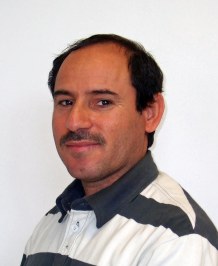
University home | Studying | Research | Business and community | Working here | Alumni and supporters | Our departments | Visiting us | About us
Exeter MR Research Centre
Vibrotactile Stimuli Group
Collaborators
Dedication of The Active Areas in the Brain during Different types of Tactile Stimulation to the Fingertip.
This medical physics project is part of a large study to establish the details of brain activation during touch perception. The project work will involve development of an electromechanical transducer to present spatiotemporal patterns of tactile stimulation of the fingertip. This stimulator is required to work in the high-magnetic-field and low-electrical-noise environmental of a magnetic –resonance imager. The device will probably involve multiple contactors on the skin of the fingertip; each of which has a piezoelectric drive mechanism. Each contactor will be under individual computer control. The project will be based at the Exeter MR Research Centre and in the School of Physics.

Cortical Activation Associated with Tactile Movement: fMRI study of Tactile Movement in Attentive Subjects
The Exeter 100-element tactile array was used to produce virtual touch sensations on the index finger of 8 subjects during fMRI. Moving stimuli were produced by sequentially vibrating the ten adjacent rows of the array, with 9 "sweeps" over the 12 s stimulus block. For stationary stimuli, all rows of the array were vibrated simultaneously, using a similar timing pattern. Stimuli produced by vibration at 40 Hz and stimuli produced by vibration at 320 Hz were tested in separate sessions.
References
A functional-magnetic-resonance-imaging investigation of cortical activation from moving vibrotactile stimuli on the fingertip. Summers IR, Francis ST, Bowtell RW, McGlone FP, Clemence M.J Acoust Soc Am. 2009 Feb;125(2):1033-9.
Cortical changes and musculoskeletal pain: Tactile fMRI study of cortical changes in Complex Regional Pain Syndrome
Complex Regional Pain Syndrome is a painful and debilitating disease that is characterised by oedema, inflammation and excessive pain. It is thought to be caused most often by a precipitating injury, eg, bruising or fracture, but it can also occur spontaneously. The aetiology is poorly understood. There is clear evidence of changes in the affected body part, however, such a wide range of symptoms are reported that a localised disease is insufficient to explain all of them.
Therefore, it is thought that the brain's image of the body is somehow altered and sensory-motor signals are processed differently. This altered signal processing then manifests itself as the symptoms experienced by sufferers. The aim of this project is to determine if this theory is correct by using functional magnetic resonance imaging (fMRI). When information is processed in the brain there are changes in oxygen consumption in localised regions and these can be detected with fMRI.
The cortical changes will be investigated using vibrotactile equipment which will stimulate the subject's fingertips during scanning. The areas associated with the somatosensory activity can be determined and a comparison between a healthy control group and CRPS patients should then reveal any cortical reorganisation that is taking place. If reorganisation is discovered then another study will be carried out to investigate if treatment can reverse these changes.
This project is supported by DARRT and is in collaboration with clinicians at the Royal Devon and Exeter Hospital and The Royal National Hospital for Rheumatic Diseases.
References
Davies RC, Eston RG, Fulford J, Rowlands AV, Jones AM. (2011). Muscle damage alters the metabolic response to dynamic exercise in humans: a 31P-MRS study. J Appl Physiol. 111: 782-790.


